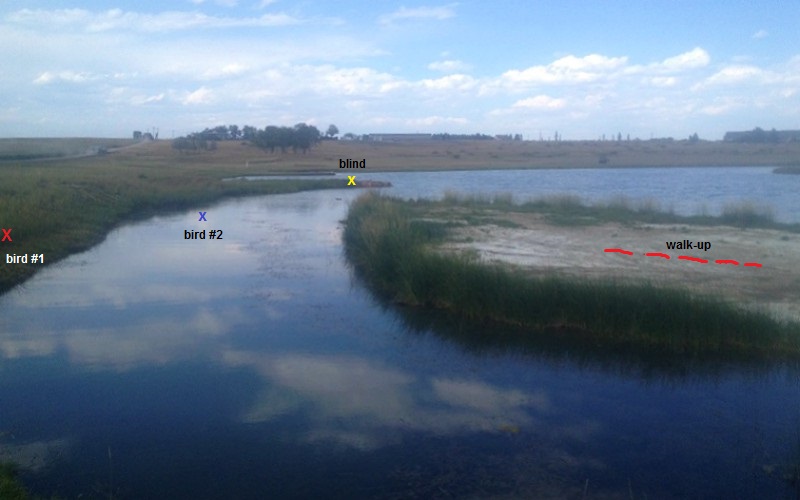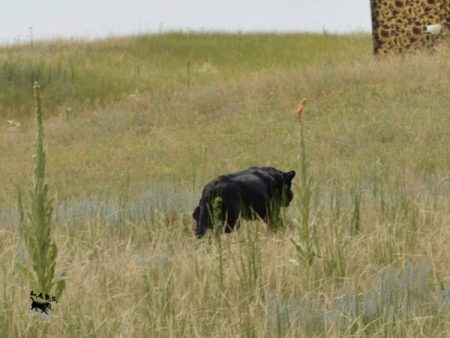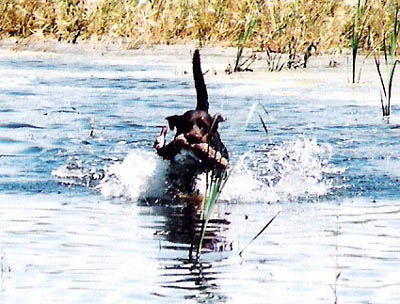
The last local AKC retriever hunting test of the season is in the books.
Beautiful property with fabulous water, good weather (yes, a bit hot) and lots of great dogs and their handlers.
There was even a chocolate Lab I've got my eye on!
My co-judge, Jeff Baldwin, drove all the way from Utah to bake in the high plains sun. Wyoming kindly sent us some of their wind every afternoon.
We designed the Senior hunting test on Friday. Jeff judged Junior on Saturday while I worked at Master. On Sunday we judged Senior together.
It was a long weekend.
What did we set up and why?
The requirements for an AKC Senior hunt test are:
- a double retrieve on land
- a double retrieve on water
- a land blind
- a water blind
- an honor
Then we had to throw in a live flyer, a walk-up, a diversion shot and multiple decoys. Plus adding some other trappings to simulate a real bird hunt. (See the Glossary below.)
We chose to start off with the land series in the morning. Having the water series afterward gave the dogs a chance to cool off in the afternoon heat.
The first two photos were taken from the "line" - the spot where handlers bring their dogs to start the test.
To begin, we called for a "handler's meeting" to introduce ourselves and describe the test. Often there are several questions.
Next we ran a "test dog" (a dog who was not in contention). He ran the test to make sure everything worked as planned and to show the handlers the test set up.
Of course, the dogs in contention didn't get to watch!
After completing the two marks successfully, the test dog and handler moved to the "honor box" which is a spot nearby where the dog can watch the next dog work.
This is often a challenge for dogs at this level.
Having just completed two retrieves the honor dog is often excited, but must be "steady" (remain quietly in place) off leash. He must watch the next dog retrieve at least the first mark.
Starting the Senior Hunting Test
Next the handlers lined up in "holding blinds" (fabric set up to block the dog's view of the test). AKC suggests dogs run in catalog order. However some handlers run dogs in other stakes and may need to run out of order.
When we were ready, we asked the handler in the final holding blind for the dog's number. Leashes come off before leaving that holding blind to run the test.
To simulate a real hunt, handlers had to shoulder and point a shotgun as each bird was thrown. The handler's gun is usually disabled for safety, but must be treated as a loaded gun. That applies even if the "gun" is only a wooden cutout.
When the handler signaled they were ready, we had bird tech #1 throw the first bird. This was a duck from a winger hidden behind a clump of trees near the left side of the field.

The bird went from right to left and landed in some rather sparse cover, about 70 yards away. Just before throwing the bird, the bird tech blew a duck call and shot a blank to get the dog's attention. There were also multiple goose decoys the dogs had to run through to get to the bird.
Many dogs wanted to retrieve right away, but they had to be steady and wait for the second bird to be thrown - a "double retrieve." This bird was a "flyer" (a live bird that was thrown and then shot in the air) which is very exciting for the dogs. All the other birds were already dead before being thrown.
The second bird
Bird #2 came out of a winger hidden behind the berm that ran parallel to and behind the line of trees. Flyers rarely land in exactly the same place so the distance to the bird varied, but averaged about 60 yards.

Because of the excitement caused by a live flyer, several dogs "broke" (ran to retrieve it before the handler's command). Dogs that retrieved the bird without being released were disqualified. However if the handler was able to stop the dog quickly (within about 15 feet) they were allowed to continue. They were penalized for a "controlled break."
Some dogs didn't break, but moved a little bit towards the birds. This is called a "creep" and is penalized, but less than for a controlled break. Dogs moving beyond the length of the gun barrel had to return to heel before they could retrieve.
After both birds were down, we had the handler send their dog. They could pick up the birds in any order, but usually chose to get the last bird down first. This is especially so when that bird is a flyer!
After delivering one of the birds "to hand" they were sent to retrieve the other bird. When the working dog was sent on the first retrieve, we dismissed the honor dog.
If the working dog did a passable job on the double retrieve, they next had a "blind retrieve."
Problems
Sometimes dogs forgot where a bird landed and had a big hunt or ran towards where they already found a bird.
Returning to an old fall and switching are both disqualifications. They are similar faults. "Returning to an old fall" is going back to where they already retrieved a bird. "Switching" is abandoning a hunt for one bird to go to a different bird.
When a dog hunted too far away from the bird or started toward the other bird, handlers blew their whistle. At that point the dog was handled to the bird using the same technique as a "blind retrieve." This means directing the dog to a bird he didn't see fall.
The blind retrieve
We "planted the blind" (placed a bird in the field when the dog wasn't watching) near a bush 50 yards away.
To get to the blind, the dog had to pass some larger bushes and diagonally cross a dirt track. The location was to the left of bird #1 and slightly out of the left side of the first photo.
For a passing score, the handlers had to "challenge the blind." This means keeping their dogs close to a direct line to the blind. Dogs should not run all around in hopes that he would eventually find it on his own.
Dogs were penalized if they didn't:
- stop on the whistle
- take the correct cast
- maintain the new direction for at least a few yards.
Senior dogs are at an intermediate level of training and still learning so each penalty was only a minor deduction.
Thirty-one dogs did a double retrieve, blind retrieve and an honor. Twenty-nine competed plus a test dog (honored the first dog) and a bye dog (retrieved while the last dog honored).
Dogs that had a passing score on land were "called back" to run the water series.
The water series
We moved a 1/4 mile south to a spit of land. There was a water channel on the left side and open water on the right.
This series included a double retrieve and a blind retrieve with a walk-up and a diversion shot. No honor, no live birds.

To start, the handler walked down the spit with their dog at heel. When they got to a certain point, there was a gun shot and a bird was hand thrown. It landed in grass about 8-10 inches tall and about 4-6 feet from the water's edge.
The second bird came out slightly left to right, with another gun shot. It landed with a splash about half way down the channel. Both bird techs were hidden behind tall bushes.
The dogs could retrieve the birds in any order. When they were returning with bird #1, there was a diversion shot to set up the blind.
Most dogs did fairly well to great on the water double retrieve. There were a few that needed to be handled to one of the birds. A few dogs needed to be handled to the memory bird on land and one of the birds on water.
The blind was across to another spit of land and was placed just out of the water.
There was some suction to old falls and to a bit of land poking out of the water. Otherwise this was a straight forward blind. All the dogs who attempted it did fine.

Summing up...
Our goal was to make both series as hunt-like as possible while staying within AKC's rules for a Senior hunting test.
We also wanted the handlers and dogs to enjoy it and to make sure everyone was safe.
Some dogs did very well overall. Other dogs did better on one series or the other. And some dogs had enough trouble that we couldn't give them a ribbon this time.
I'm grateful to the Mile High Golden Retriever Club for asking me to judge. To the owners and handlers who entered their dogs. To all the helpers for handling the myriad of jobs. And to my co-judge who made it so easy, it felt like we've been working together for years.
By the way, all of my dogs got to experience that great water.
The adult dogs loved it. The younger ones quickly learned that the end of grass doesn't always mean there's a gentle slope into shallow water. However they did get to practice new swimming skills.
And the drive home was rather quiet - except for some snoring coming from the back.
Update: I'm sad to say Jeff has left the bonds of Earth. I hope he's been reunited with family and friends and, of course, his favorite dogs. We miss him greatly.
Glossary for a Senior hunt test
BLIND RETRIEVE - The dog is sent to retrieve a bird that it did not see fall. The dog is expected to take hand, voice and whistle signals to direct it to the bird.
DIVERSION - Either a shot or a fall designed to divert the dog's attention from the task at hand.
DOUBLE - Two birds to retrieve.
HONOR - Dog to sit quietly off-leash on or near the line while another dog retrieves.
MARK - A retrieve that the dog has seen fall.
MEMORY BIRD - First bird the dog sees thrown/shot on a multiple mark. Usually the last retrieved.
STEADY - Dog does not leave assigned spot until instructed by the handler to retrieve.
WALK-UP - Bird is thrown while handler and dog are walking with the dog at heel, much like jump shooting.
By: Rich Carpenter
You can see the entire glossary on the Platte Valley HRC's website.
Originally published September 22, 2018.





